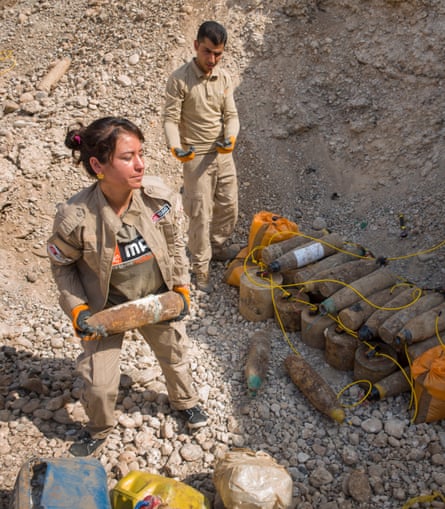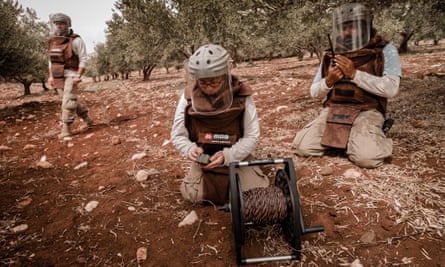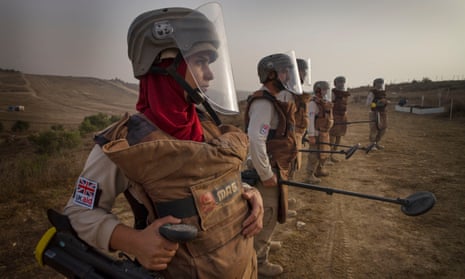As a child, Hana Khider dreamed of Sinjar. Born and brought up in Syria, she remembers her mother telling her stories about the district in northern Iraq where her relatives lived. “I always imagined it in my mind,” she says, smiling over our video call. “It was beautiful and peaceful.” Today, Sinjar is her home. She lives with her husband and three children in a village close to Mount Sinjar, which she describes as “very special to our community”. Khider is Yazidi and they believe the mountain was the final resting place of Noah’s Ark. The rocky peak has long been considered a sacred refuge for persecuted people.
It was the mountain that saved her and more than 40,000 other Yazidis when they fled Islamic State in August 2014. Driven from their villages, they camped on the mountain for months – some for years – after a genocide that, according to the UN, saw 5,000 Yazidis massacred and up to 7,000 women and girls captured and sold as sex slaves to Isis members. “We feared for our lives,” Khider, now 28, says, explaining how Isis fighters surrounded the mountain. Luckily, she escaped to Kurdistan, where she lived in an internally displaced persons (IDP) camp until her village was liberated. Her family returned in May 2016. A few months later, she applied to work as a deminer at the Mines Advisory Group (MAG), a charity that finds and clears mines in places of conflict.

“All Yazidis want to do something to make Sinjar as it was before the war,” Khider says. “So when I heard about an organisation that removes war remnants and frees the land from the danger of death, I felt eager to work with them.” The Yazidi heartland remains infected with Isis’s legacy. As well as unexploded ordnance (UXO) such as mortars, projectiles and grenades, Isis purposefully left improvised explosive devices (IEDs) everywhere. They are inside containers, cooking pots, mobile phones, even children’s toys. Teams of deminers carefully comb the land and work through homes to identify IEDs that to this day kill and maim locals. Early last December, four children were playing in the village of Qabasiya, a 10-minute drive south of Sinjar, when two of them were killed after stepping on an IED. The other two are in hospital with critical injuries.
This is why Khider and many other Yazidi women are becoming deminers. “My work is a message to Isis: ‘We are strong and we cannot be defeated,’” she says. This determination was evident in a recent National Geographic documentary, Into The Fire, which followed Khider as she led an all-female team of deminers. In one scene she is tending her garden and feeding her three children; in the next she is detonating mortars, pulling out mines and searching for IEDs in war-ravaged towns, a sun hat on her head and a pair of gold earrings glimmering in the sunshine.
The job of a deminer used to be considered “men’s work”, partly because of the danger and partly because of the physical demands – it is slow and arduous. But this view is changing. Khider is now overseeing a mixed-sex team of 14 members. Her work begins at 5am, when she arrives at the MAG base to get instructions and meet her team. They then drive to a contaminated village and clear mines until around 2pm. Out in the field, every step Khider takes is fraught with danger, but each one takes her closer to the Sinjar she dreamed of in her childhood; one that’s peaceful and free of mines. She has also helped make big strides towards gender equality in a male-dominated sector. I ask her if she’s ever faced any resistance from men in her role as a team leader. “When we – myself and my female colleagues – first started working as deminers, it was a strange thing in the community,” she says. “But they were also very open to that. I got support from my husband, from my family, my relatives and the beneficiaries of the land we cleared.”
Holivan Khero, 22, a deminer from a nearby village, agrees. “In our community, men and women are equal, so it is fine for me to be a deminer. People are proud of me,” she says. “I am not scared.” Her family relocated to Germany after the genocide, but she wanted to stay to help rebuild her community. “If our land was clear of contamination and there was not that danger, my family would still be here,” she says. A map of northern Iraq is stuck to the wall behind her, red dots marking the contaminated areas like beacons announcing the hidden scars of war.

In 2016, MAG was the first demining organisation in Iraq to deploy female deminers. It now has 24 Yazidi women working for it. Jack Morgan, MAG’s director in Iraq, says they are planning to hire an additional 10 women from Mosul in the coming weeks. “They’re driven to clear this land,” he says. “You get the feeling that, for them, it’s personal.”
At the start of this month, a 24-year-old man working for MAG was killed in an explosion at a munitions storage facility in Iraq’s Telefar district – a reminder of the dangers these deminers face every single day. Iraq has around 1,800 sq km of contaminated land (an area bigger than Greater London) stemming from multiple conflicts, including the Iran-Iraq war in the 1980s, the Gulf War, the 2003 US-led invasion, and the Isis occupation of 2014. The Iraqi government has a target deadline of February 2028 to clear the country, which Morgan thinks is optimistic. “Last year, operators cleared just over 15 sq km,” he says. Covid-19 hasn’t helped. This year MAG has managed to disarm 1,200 mines; usually it would be 6,750 mines.
Lebanon is another Middle Eastern country that is slowly but surely defying gender norms when it comes to mine action. I visited last September to observe MAG’s work in the south of the country. The sunbaked earth radiated heat as we crossed the Litani river, which meanders through a valley between looming, craggy mountains. Southern Lebanon is known for its fertile land; we passed olive groves and apple trees. Our driver listed all the other crops that grow here: apricots, figs, tobacco. It looked idyllic. But, according to MAG, since 2006, 70 people have been killed by landmine or other UXO in Lebanon and 470 people have been injured by a mine or UXO.
We went to the Blue Line, a 120km border demarcation between Israel and Lebanon, which is currently patrolled by UN peacekeepers. As we approached, I saw more and more of the infamous red triangular signs bearing a skull and crossbones, a warning to watch our step. Dotted around here are some of an estimated 400,000 mines laid by Israel during the country’s occupation of southern Lebanon in the 1980s. This contamination was added to during a brief conflict in 2006, when tensions flared between the countries and 4m cluster submunitions were dropped by Israel. Around 40% do not detonate on impact so, like landmines, they lie under or on the ground until an unsuspecting civilian steps on it, sometimes decades later.
A team of MAG deminers is busy clearing them. We walked (cautiously) towards them. They looked up from their work and gave us a wave. Upon closer inspection, I realised that more than a handful were women – some of the 30 female deminers working for MAG in Lebanon. One is Hala Naame, 31, from a village close to Nabatieh, the city where MAG is based. She has long, dark hair and a shy smile, and had been working since dawn in temperatures that reached 37C in the afternoon. Under the heavy protective body armour it must have felt like an oven – deminers wear outfits like this for most of the day. But Naame wasn’t fazed. “When I am out in the field demining I think about protecting myself as a priority because I have a family,” she told me during her lunch break. She has a five-year-old son. “I worry he might be injured or killed if he steps on a mine – all children love to play outside.”
The team showed me around the minefield they were working on, near the village of Houla. Anti-personnel mines nestled in the vegetation or poked out of the ground. They detonated 11 in three controlled explosions; the booms echoed through the trees. Once this land is cleared it can be used by farmers to grow crops and graze livestock, which is the main source of income in the rural south.

So far this year, MAG has cleared close to 15,000 mines in Lebanon. Mofida Majzoub, 40, from Sidon, is a site supervisor for the NGO’s operation in the north-east, an area close to the Syrian border. She was previously a freelance photographer, but after 25 days of training in 2016 she became a deminer. In 2019, she was promoted to site supervisor and now looks after a team of 12. “I make sure I am conducting the safety procedures in order to make the deminers safe. It’s a great responsibility, though some of my friends are like, ‘You’re crazy,’” she laughs.
During my trip I encounter women in every part of the demining process, from community liaison officers to team leaders and programme coordinators. Despite appearances, progress is slow. In 2019, a Mines Action Canada survey of 12 NGOs involved in landmine clearance around the world, including MAG, the Halo Trust, and the Danish Demining Group, found that women made up only 20% of operational staff. Hiba Ghandour, MAG’s gender and diversity officer in Lebanon, says getting more women into operational positions will not happen overnight: “It’s a process, but we’re getting there. There’s no solid rule; we’re constantly learning. There shouldn’t be any area where someone says it’s not for women.” Particularly with Lebanon’s current economic situation, giving women opportunities is now more crucial than ever. “I have heard 90% of our female staff say, ‘We are helping our husbands, fathers, family – without us they could not survive.’”
For the naysayers who think women are incapable of taking on the role of deminer, Ghandour says that in every training session she runs, someone will always ask: “Is it a woman’s job?” and a site supervisor will pipe up, saying the female deminers in their team are doing better than some of the males – and sometimes better than all the males.
But sometimes doing a good job is still not enough; it’s attitudes that need changing. Arianna Calza Bini, director of the Gender and Mine Action Programme (GMAP), a division of the Geneva International Centre for Humanitarian Demining, delivers gender mainstreaming training sessions to people working in mine action around the world. She recalls several sessions with women in the Middle East who told her their male colleagues “constantly ask them questions like: ‘What are you doing here? Why aren’t you at home with your kids? Why are you working, not your husbands?’” She explains: “Often mine action is considered an area where mainly ex-military men work.”
Bridget Forster is ex-British Army and works for the United Nations Mine Action Service (UNMAS). She recalls being told she was “too weak to dig a hole” in the early days of her mine action career. In 2018, she completed her explosive ordnance disposal (EOD) training and was one of eight women working for UNMAS who won the UN secretary general award for gender parity in 2019, which she hopes will start to “change the mindset a little”.
After a stint in Libya, she is currently the UNMAS programme manager in Palestine, overseeing the national authority’s mine clearance that occurs on UN premises in Gaza and the West Bank. UNMAS started working there in 2009 following the 2008-9 hostilities between Gaza and Israel, which left significant contamination and is still being added to when violence escalates – most recently in 2019. So far, they have cleared 354 explosive remnants of war (ERWs) and 7,324 ERWs have been cleared under UNMAS supervision. Her team in Palestine is 90% female and she actively encourages local women in Gaza to engage with risk education, as well as leading preparedness strategies (in case of further escalation) in their own households.
“We only have to look at the UN Security Council Resolution 1325 which looks at the engagement of women in the peacebuilding process. Despite what many men tell me, women do want to be involved in peacebuilding. When we start to engage with women in communities, the first thing they say is, ‘Thank you, our voice needs to be heard, we can make a difference and nobody has ever asked us before.’” She adds that this will help empower the next generation of women, which is particularly important in Gaza, where previously “there was this idea of powerlessness and a lack of agency. They’re effectively in an open-air prison.”
Shahad Alobaid, 30, is a liaison officer for UNMAS in Mosul, Iraq, where she plays a critical role speaking to local people, collecting information about UXO, and prioritising tasks for the clearance teams. She was in her final year studying English at Mosul University when Isis invaded in 2014. Her father wouldn’t let her or her three younger sisters leave the house while Isis occupied the city, for their own safety. “I was a prisoner in my own home for 30 months,” she says. “Those were very long days and nights.” This was made harder when her father died of a heart attack in 2016. “After that, my sisters and I didn’t have anything to lose. I felt like it was OK for me to die.”
Alobaid’s neighbourhood was liberated by Iraqi forces in January 2017. “The only thing I focused on was getting a job to feed my family.” She began working for a private demining company in April 2017 as an interpreter and then as a liaison officer for UNMAS. “I was the only girl on the team in Mosul. Most of them were ex-military men who had been in the higher ranks like generals and lieutenants. To them I was this little girl.” She says it took time for them to accept her: “I had to prove to them that I could do this.”
Her mother also took some persuading at the beginning. She eventually agreed to let her eldest daughter work in mine action on one condition: “She told me not to tell anybody, like our relatives or neighbours, what I was doing. She said to tell them I was working at college instead.” Their secret lasted for nine months. “Once my mother saw the confidence I gained by communicating with people and helping the community, she was very proud.” Alobaid – like many other women working in mine action – is contributing to the survival of her once war-torn city, rebuilding it from the ground up. In doing so, she has rebuilt herself. “I feel like I’m a human being again,” she says.
